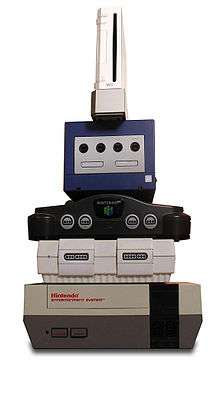U-Force
The U-Force is a game controller made by Brøderbund for the Nintendo Entertainment System.[1] It employs a pair of perpendicular consumer IR sensor panels to translate the user's hand movements into controller signals.
From a print advertisement c. 1989:[2]
Introducing U-FORCE, the revolutionary controller for your Nintendo Entertainment System. So hot, no one can touch it. Now you can feel the power without touching a thing. It's U-FORCE from Broderbund - the first and only video game controller that, without touching anything, electronically senses your every move, and reacts. There's nothing to hold, nothing to jump on, nothing to wear, U-FORCE creates a power field that responds to your every command--making you the controller. It's the most amazing accessory in video game history - and it will change the way you play video games forever. It's the challenge of the future. U-FORCE. Now nothing comes between you and the game.
Reception
The U-Force was ranked the eighth worst video game controller by IGN editor Craig Harris.[3] MSN listed it as one of the top 10 worst game peripherals, writing "Second only to the Sega Activator in terms of all-out crappiness, the U-Force also used infrared sensors to create a truly nightmarish controller...'Don’t Touch' said the adverts for the device, in a rare example of an advertising campaign that got it spot on."[4]
See also
- Freedom Stick and Supersonic the Joystick, contemporaneous joysticks for the NES that also used IR technology
References
- Tricked-out Videogames, BY FRANK VIZARD, Popular Mechanics, Oct 1989, Page 106
- Original advertisement
- "Top 10 Tuesday: Worst Game Controllers". IGN. 2006-02-21. Retrieved 2013-09-16.
- "U-Force". MSN. Archived from the original on 6 September 2009. Retrieved 23 September 2009.
